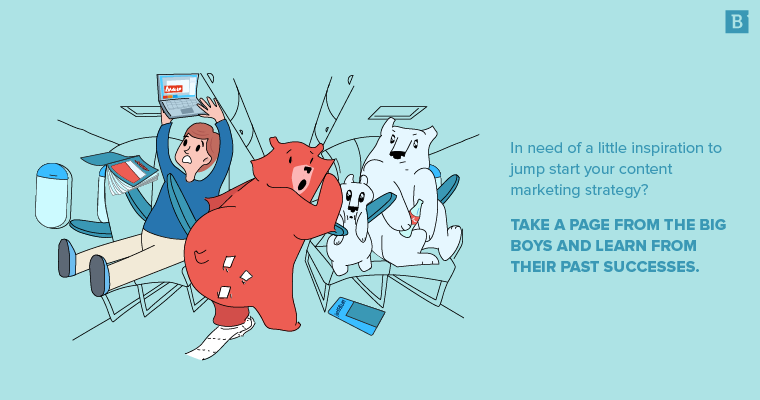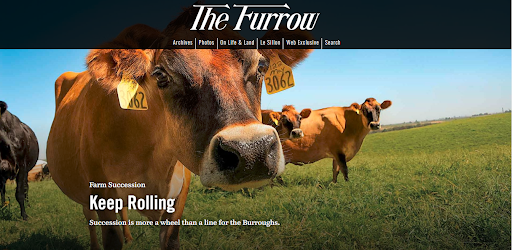Let’s be honest: Content marketing is hard. Between the strategizing, analysis, content production, dissemination, endless audits, reviews and tweaks, good content marketing is, as they say, an all-hands-on-deck affair. You need to coordinate different departments and stakeholders and meticulously form a plan of attack that hits the right audience at the right time with the right message.
Even when you seemingly do everything right, things can go wrong. It’s times like those where we may be tempted to throw our hands in the air and say “Enough!” In those moments of despair, it’s helpful to revisit some past success stories to feed our inspiration.
The following content marketing case studies aren’t just proof that the right approach will pay off, they provide ample fodder for your next marketing campaign. Want to learn from the biggest name brands around? Thought so. Then take a look at these marketing examples and what they can teach you about crafting a better strategy and executing on it.

1. Coca-Cola Goes Viral
Even household names like Coca-Cola rely on content marketing to support their brand and boost customer engagement. With soda sales steadily declining over the past decade-plus, the iconic soft drink manufacturer has fully embraced digital channel outreach to help turn the tide back in its favor.
Coca-Cola’s content marketing strategy has its roots in the brand’s „Content 2020“ campaign„, which dates all the way back to 2012. That initial foray into the world of content marketing pushed brand stakeholders to move away from relying on typical 30-second TV advertisements, ubiquitous signage and the odd blockbuster Super Bowl spot to capture an audience.
The idea was simple: Create compelling content to help build a digital presence and engage consumers on a wider variety of channels. How the brand went about achieving that goal was a little more complex.
It created a network of guest bloggers to contribute to its site, cultivating young, exciting talent to help reach new audiences. The brand launched unique promotions and giveaways on different platforms, including a dedicated mobile app. It really took advantage of just about every conceivable form of media at its disposal. In one of its riskier moves, Coca-Cola distributed video camera-equipped bottle openers in Pakistan and India to encourage customers to upload their recordings on social media and highlight the shared experiences that people on both sides of the countries’ decades-long conflict enjoyed.
The idea was simple: Create compelling content to help build a digital presence and engage consumers on a wider variety of channels.
Perhaps the most visible strategy Coca-Cola has embarked on has been its “Share a Coke” campaign, which initially launched in Australia in 2011. The brand took the concept of personalization to its natural endpoint, designing special bottle labels featuring one of the 150 most popular names in Oz at the time. The campaign encouraged customers to give the monikered bottles to friends and family as gifts, track down products featuring their own names and share pictures and videos on social media networks. Coca-Cola even incorporated those customer experiences back into its marketing and advertising.

„Share a Coke“ was a massive success Down Under, going viral and helping the company move 250 million bottles and cans during its first summer. That’s roughly 10 units per Australian resident, for those keeping score at home.
Coca-Cola subsequently rolled out the campaign to other markets with similar results. The “Share a Coke” project has often been credited with helping the brand reverse its declining sales figures.
The Takeaway
In short, the brand left no stone unturned in its quest to craft a sound content strategy. It wasn’t afraid to roll the dice on out-of-the-box ideas while still supporting a solid digital marketing strategy. And while we all don’t have the resources that “big pop” has to invest in such wildly ambitious projects, we can still learn from that willingness to experiment, commit to a strategy and see it through to the end. It paid off, and its content strategy was a fantastic success.
Content creation can include incorporating new forms of media into your inbound marketing strategy. Mobile apps, podcasts, quizzes, interactive infographics – it’s all on the table. Don’t be afraid to try something new with your target audience. It could just be the best thing to ever happen to your digital marketing strategy.
2. JetBlue Leans into Passenger Concerns
The airline industry has had its fair share of PR nightmares over the last few years, from aggressive removal tactics to lost pets to extensive delays. Combine that with shrinking seats, disappearing perks and nickel-and-dime pricing plans, and you have a field that struggles mightily to convey the right message to its customers.
Under those conditions, you would think a premier, luxury airline would be in the best position to showcase its brand as standing above the fray and one that truly understands its customers. You would think that, but you would be wrong.
Low-cost airline JetBlue may just be the industry leader when it comes to content marketing, consistently pumping out thoughtful, engaging and compelling content that speaks directly to its brand values.
Whereas competitors are busy doing the same ol’ advertising campaigns, JetBlue’s content marketing strategy focuses on the human experience, treating their audience like actual people.
Imagine that?
Whereas competitors are busy doing the same ol‘ advertising campaigns, JetBlue’s content marketing strategies focus on the human experience, treating their audience like actual people.
In particular, the airline has constructed several campaigns that address some of the most common in-flight issues that can derail the passenger experience. It has an entire series of videos tackling flight etiquette, urging passengers not to bring stinky food with them on the plane and giving window seaters the best strategy to move past their sleeping co-passengers when nature calls.
JetBlue has even waded into the touchy subject of flying with infants, launching a campaign that awarded passengers rewards program points every time a baby cried on one of their flights. At every turn the airline’s content strategy has focused on not only showing customers that JetBlue cares about their experience, but also using that content as a means to actually improve it.
The Takeaway
Every industry and market niche has its own pain points and sources of irritation for customers. As JetBlue has shown, sometimes it’s better to lean into those issues and address them head on rather than try to downplay them or ignore them altogether. Acknowledging your customers’ concerns and demonstrating your commitment to solving those problems can go a long way. It makes for good content too.
3. IBM Builds Its Network of Social Media Influencers
IBM may be one of the oldest tech companies around, what with it being virtually synonymous with the gargantuan mainframe computers of days gone by. Yet that doesn’t mean the brand can’t flex its social media marketing muscles with the best of them.
The company’s content marketing strategies have been remarkably robust over the years, posting instructional how-to videos on YouTube and aggregating the brand’s entire digital output, including blog post content, videos, graphics and social media posts, into a single live feed.

But that’s nothing compared with IBM’s work developing a network of social influencers to help build brand awareness with an audience that may view the company as a relic of the past. For several years now, IBM has cultivated working relationships with influential industry writers and well-respected commentators across the entire IT landscape.
IBM’s business model stretches into different sectors – each of which have their own specific IT-related concerns and issues – so the company’s stable of influencers includes writers and thought leaders who have their own areas of expertise from which to really speak intelligently and authentically about those problems.
With all of these knowledgeable, respected and trusted IT professionals crafting guest blog post content for IBM, the brand can showcase a high level of authority across a massive range of tech topics – and it all rings true with readers because it’s coming directly from the industry’s foremost thinkers.
The Takeaway
IBM doesn’t just go out and find the biggest name around. It strategically picks different influencers for various demographics and personas within its customer base. Successful influencer marketing strategies depend on matching the brand with the mouthpiece and the audience. Getting your name in front of a large number of users on any given social media platform doesn’t mean much when the message lacks authenticity and the support of your influencer. Choose your partners wisely.
There’s also something to be said for IBM’s willingness to embrace guest blogging. If you’re on the fence about having articles written by third parties appear on your company blog, consider some of the benefits that go hand in hand with a sound guest blog strategy:
- Increased website traffic.
- Exposure with new potential customer demographics.
- Greater industry authority.
- More referral traffic through external links.
Showcasing industry experts and deeply knowledgeable viewpoints on your blog is always a good move, even if those insights aren’t necessarily coming from your own employees.
4. AARP Goes Beyond Analytics
Data drives every aspect of content marketing, but there are some instances where metrics, KPIs and analytics reports don’t tell the whole story. AARP, that bastion of cutting-edge thought leadership, combines a data-driven marketing strategy with its own novel approach to developing relevant, better content: just asking readers what they want to see more of.
The organization actively solicits feedback from its members through social media, email and even good old-fashioned letters (these are retirees, after all) to get a better idea of what they like and dislike with AARP content. Future issues and publications are crafted with those comments in mind, and content is continually tweaked and reworked to best meet reader expectations.
More than half of AARP members say they have read three out of the last four publications they’ve received.
That approach seems to be working: More than half of AARP members say they have read three out of the last four publications they’ve received. Imagine having that kind of return rate on your email marketing campaign.
The Takeaway
Having cold, hard data to back up your marketing strategies and content production decisions is great – ideal, even. Every aspect of your inbound marketing strategy should be informed by data and analytics. If you’re doing something because of what you think you know rather than what you can prove with raw numbers – whether it’s creating specific forms of content, targeting a particular segment of your audience, covering different subject matters, or identifying goals – you could be heading down the wrong path.
Don’t overlook the importance of speaking directly with your audience members every once in a while and picking their brains about your content. You can always look for correlations between organic traffic figures and topics or content types, but it’s also helpful to just straight-up ask returning visitors and existing customers what they found compelling about your content marketing campaign.
These conversations occur pretty organically during the sales process, and can help guide your content marketing efforts to drive more traffic to your site and generate more qualified leads.
5. John Deere Updates Brand Content for the Digital Age
Although content marketing is often considered a recent development borne out of a need to respond to the rise of search engines and evolving customer journeys, its roots actually extend much further back in time well before the digital age. Some even argue that Ben Franklin’s “Poor Richard’s Almanack” was the very first example of content marketing in action, since the founding father used the publication primarily as a means to promote his printing business.
Along the way, there have been numerous major landmarks that led us to where we are today, none more so important than John Deere’s magazine, “The Furrow.” Since 1895, The Furrow has served as a source of agricultural news, insights and advice, earning itself a legion of dedicated readers. At the height of the magazine’s popularity in 1912, more than 4 million people subscribed to The Furrow.

While the print edition still remains incredibly popular with readers, John Deere has updated the publication to appeal to digitally native consumers. The online version of “The Furrow” is as informative and engrossing as ever, featuring stories on cutting-edge agricultural innovations like robotics, vertical farming and the Internet of Things. The brand has effectively dragged the millennia-old practice of farming into the digital age – and it didn’t need to skimp on the quality of the content one bit to get there.
The Takeaway
What’s old is new again. There are actually a few takeaways to glean from The Furrow’s continuing success over the years. First, the magazine wouldn’t have survived this long if it didn’t feature high-quality content. John Deere’s publication has deftly balanced informative and educational content that advises farmers how to manage their family-owned businesses with branded material that showcases John Deere’s authority in this space. For more than a century, readers have kept coming back because they find the publication valuable. Through that, the company has established itself as a trusted thought leader in its field – a source of information for the most important industry developments and purveyor of thoroughly tested farming best practices.
Your content needs to be substantive and provide readers with insights, advice and takes that can’t be found anywhere else. Content has to mean something, otherwise it’s just noise.
John Deere has effectively dragged the millennia-old practice of farming into the digital age – and it didn’t need to skimp on the quality of the content one bit to get there.
The second lesson here is to always look for opportunities to update your content to reflect the latest trends, news and shifts in target audience demographics. John Deere probably could have continued pumping out physical copies of The Furrow filled exclusively with farming tips and machinery reviews with relative success, but instead chose to tie in high-tech and digital developments to round out the high quality content. You never want to fall into complacency and regurgitate the same old content over and over again. Keep looking for ways to give your audience insights they won’t be able to find with other companies in your space.
6. Charmin Finds Its Own Brand of Toilet Humor
You can only hawk toilet paper for so long before you stop taking yourself seriously. That isn’t to say that Charmin doesn’t diligently protect and manage its brand. But over the years it hasn’t been afraid to add a twinge of humor to its messaging and outreach every now and then.
Case in point: Charmin’s free SitOrSquat mobile app, which provides users on the go with a map of nearby bathrooms where they can … well, go. As anyone who’s experienced Chicago’s draconian public restroom policies can tell you, the app is extremely practical while also throwing a nodding wink toward Charmin customers. It even allows users to upload reviews of different spaces and rate the cleanliness of the facilities – hence the “SitOrSquat” title.

The Takeaway
Far be it from us to suggest that every brand release their own restroom-location platform, but it’s worth taking note of Charmin’s willingness to poke fun at itself and inject its brand messaging with a healthy dose of humor.
It’s OK to have fun every once in a while. Your audience will thank you for it.
Need more convincing? Salesforce’s U.K. operation (cleverly called Salesforce UK) was lagging well behind its American counterpart in both organic traffic and lead generation before it completely revamped its digital marketing strategy to add in some fun, light-hearted interactive content with all of the usual, grave CRM talk. Even those famously staid and priggish Brits ate it up, including a series of fun, breezy videos that educated and entertained in equal measure.
It didn’t take long for Salesforce UK to see tangible results: Site traffic increased 80 percent and a single eBook resulted in roughly 10,000 downloads. We’ll hazard a guess and say the brand’s lead generation and conversion rates are looking pretty good right about now.
Don’t be afraid to pepper in some irreverent – dare we say, even goofy – takes with the rest of your content. Yes, that means you too, B2B brands. Not every blog, infographic and video needs to be a deathly serious breakdown of some industry trend. It’s OK to have fun every once in a while. Your audience will thank you for it.
7. Adobe Gets B2B Customers Involved With User Generated Content
User generated content has been a hallmark of B2C content marketing ever since Burberry launched its “Art of the Trench” campaign back in 2009. In many ways, it’s the perfect way to encourage customers to interact with your brand at a time when social media networks run rampant and every consumer has a smartphone capable of snapping a photo or recording a video at a moment’s notice.
B2B brands have, for the most part, missed out on the user generated content party, though. That business model just doesn’t naturally lend itself to this kind of content. Although, personally speaking, the world could use more videos of giddy data center managers breathlessly showing off their latest server racks, UPS equipment and cooling systems.
If you’re struggling to see how user generated content applies to your B2B organization, consider Adobe’s approach.
The software company has a wide userbase, including both consumers and business users, but its UGC marketing strategy manages to target both demographics simultaneously. Adobe encourages Photoshop, Illustrator and Lightroom users – among other Adobe software platforms – to share their creations on the brand’s Instagram page.

Adobe’s B2B users can show off the great work they’ve done on recent advertising or marketing campaigns and the various materials they have created using Adobe products. It’s a chance for those customers to showcase their expertise and capabilities, thereby enabling them to build their own brand awareness and attract customers.
Meanwhile, Adobe encourages customer engagement and interaction, further burnishing the relationship it has with its dedicated users. Not to mention, Adobe customers can be inspired by the work posted on its social media pages to explore new software features and push themselves to become expert Adobe users themselves. It’s a win-win.
The Takeaway
Adobe’s example shows that there are valuable applications for user generated content in the B2B space (consumer-focused companies really shouldn’t need that much encouragement or inspiration for incorporating UGC into their content marketing plans). You may have to get a little creative to come up with a setup that’s beneficial for everyone involved, but that will only differentiate your brand from everyone else.
Of course, you could always go a more traditional route and encourage your clientele to submit UGC-like testimonials. Whatever approach you take, don’t shy away from user generated content. Social proof is an important element to any marketing strategy – content-based or otherwise – so be sure you’re actively working with your existing customers to showcase your product or service in the best light.
Content Marketing That Works
Whenever you need a little content marketing inspiration, look at what the most successful brands in your space are doing and incorporate some of those same marketing strategies into your own campaigns. There’s no sense in reinventing the wheel when there are so many case studies and examples out there to fuel your marketing efforts.
If you want to be the best, you first have to learn from the best.
Editor’s Note: Updated January 2023.





